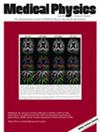Impact of range uncertainties for intensity-modulated mixed electron-photon radiation therapy
Abstract
Background
In the context of mixed electron-photon radiation therapy (MBRT), while the necessity of robust optimization to setup uncertainties is well-established, range uncertainties have yet to be investigated.
Purpose
This study provides the first assessment of the impact of range uncertainties on MBRT plans.
Methods
The percent depth dose of 2 electron beams (6 MeV and 20 MeV) and 1 photon beam (6 MV) are calculated by Monte Carlo using EGSnrc in slab phantoms. Range uncertainties are simulated by generating two copies of the phantom with each voxel's mass density upscaled or downscaled by 3.5%. Two clinical plans for a leg sarcoma case and a post-mastectomy breast case were replanned with MBRT with 2 optimization methods: once without robust optimization and once with robust to both setup and range uncertainties.
Results
Dose discrepancies between the percent depth doses of density-scaled phantoms and the nominal phantom were found to be much larger for electron beams than photons with maximum differences of 6.9% (6 MeV) and 5.5% (20 MeV) versus 1.6% (6 MV) of the maximum dose. In both clinical cases, the region of largest dose discrepancy between the range and nominal scenarios was found to be along the electron's beam path, starting immediately downstream from the target and within a few cm. Even without robust optimization, dose-volume histograms (DVHs) of all relevant structures were not meaningfully degraded under range scenarios. In the breast plan, the ipsilateral lung's V20Gy increased by 1.9% under the worst range scenario. No substantial change in the DVHs of range scenarios were observed between the robustly and non-robustly optimized plan.
Conclusion
In the two investigated cases, robustness to range uncertainties was not improved in robustly optimized versus non-robustly optimized plans. A larger study comprising more patients and treatment sites remains to be performed to adequately assess the necessity of robust optimization of MBRT plans to range uncertainties.


 求助内容:
求助内容: 应助结果提醒方式:
应助结果提醒方式:


